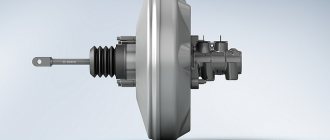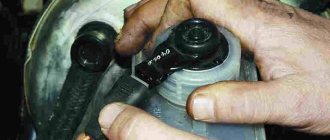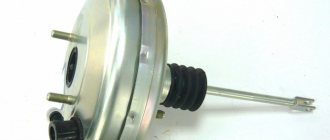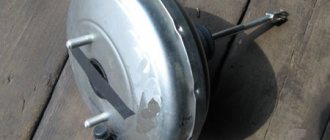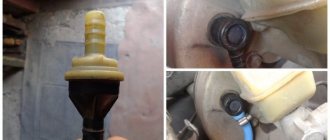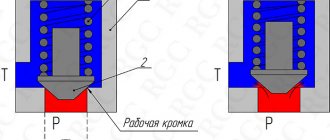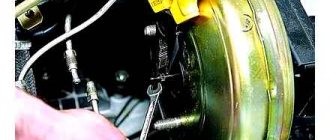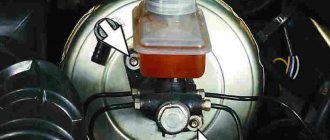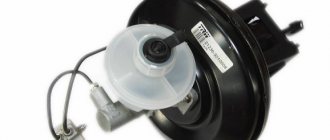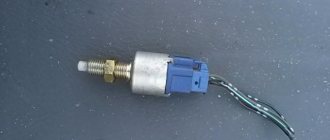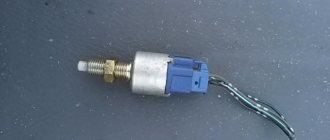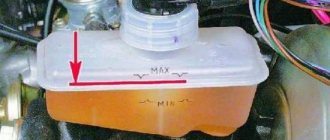Checking the vacuum brake booster of the VAZ 2114, replacing it at home
VUT is, of course, a very important mechanism in the braking system of a car. Its malfunction can become a source of danger, so periodic performance checks are required.
Next, we will talk about indicators of malfunction of the vacuum brake booster on VAZ 2114 cars, and the algorithm for replacing it yourself.
Checking and adjusting the operation of the brake system pressure regulator
- check the pressure regulator for damage to it and its parts;
- the plug should be recessed 1-2 mm into the body;
- Absence, excessive or insufficient piston stroke indicates poor performance of the regulator and its drive. In this case, it is necessary to replace or repair the pressure regulator and its drive.
Brake pressure regulator device for VAZ 2114, VAZ 2115, VAZ 2113
Brake pressure regulator VAZ 2114, VAZ 2115, VAZ 2113
Checking the VAZ 2114 vacuum booster with your own hands
To diagnose any problems with the VUT, it is enough to take a closer look at the operation of the brake pedal. If at one moment it was necessary to exert more effort so that the vehicle began to slow down, you can judge that the vacuum brake booster is not working well . To check, do the following:
- Stop the car, turn off the engine.
- Press the brake pedal repeatedly, then stop it mid-stroke.
- Without removing your foot from the pedal, start the car.
If the VUT is working properly, the brake pedal will fall down; if this does not happen, the brake system is not in order.
Checking and adjusting the parking brake system
If you notice that the car does not hold on a slope of 25%, then you need to adjust the parking brake system:
- loosen the locknut by tightening the adjusting nut, while tensioning the cable;
- We check the full stroke of the lever, which should be from 2 to 4 teeth per sector, and then tighten the locknut. For more details, read the article: How to pull the handbrake?
Visually inspect the vacuum brake booster of the VAZ 2114
- Check whether the connection between the pipe and the check valve is tight.
- Make sure the flange is intact.
- Inspect the bends of the pipes. They will need to be replaced if cracks or wet marks are found.
- If the shank seal located under the steering column is damaged, the vehicle will brake on its own.
- To make sure that this is the cause of the brake system problem, you need to remove the mat and carefully inspect the protective cap. When it sticks, the shank seal is faulty.
- Remove the cap and start the engine. Rock the valve stem several times. If there is a hissing sound, there is clearly a breakdown.
If at least any of the listed symptoms are present, the VUT VAZ 2114 needs to be replaced.
Checking and adjusting the VAZ 2115 pressure regulator drive
Place the vehicle on a lift or inspection ditch. The car must be on wheels and in running order.
Push the rear of the car, applying 2-3 times a force of 392-490 N (40-50 kgf), directed from top to bottom on the rear bumper of the car, to set the rear suspension to the middle position.
Rice. 6.16. Adjusting the pressure regulator drive: a) 1 – template; 2 – device lever; 3 – roller; 4 – pressure regulator drive lever; 5 – bracket; 6 – load; A - lever stop; b) 1 – rod
Install between the rear suspension arms and the body of the rod 1 (
Rice. 6.3. Pressure regulator drive: 1 – pressure regulator; 2, 16 – pressure regulator mounting bolts; 3 – bracket for the pressure regulator drive lever; 4 – pin; 5 – pressure regulator drive lever; 6 – axis of the pressure regulator drive lever; 7 – lever spring; 8 – body bracket; 9 – pressure regulator mounting bracket; 10 – elastic lever of the pressure regulator drive; 11 – earring; 12 – earring bracket; 13 – washer; 14 – retaining ring; 15 – bracket pin; A, B, C - holes
A preliminary assessment of the setting of the pressure regulator drive can be determined by the gap between the lower part of lever 5 (see Fig. 6.3) of the pressure regulator drive and spring 7. The gap should be in the range of 2–2.1 mm.
The pressure regulator drive is adjusted using device 67.7834.9512, for which:
– disconnect the shackle 11 (see Fig. 6.3) from the pin of the rear suspension arm bracket and lower the shackle down. Install a device on the axis of the rear suspension arm bracket (see Fig. 6.16a) to adjust the pressure regulator drive to a position where stop A of lever 2 of the device rests on the shelf of the rear suspension arm connector;
– hook the grip of the load cable 6 to the bracket 5, and throw the cable over the roller 3 and, lightly pressing the load down with a force of approximately 4.9 N (0.5 kgf), lower the load [the mass of the load should be equal to (1.5 ± 0.05) kg];
– make sure that lever 4 does not touch the rear suspension arm;
– install template 1 on the axis of the rear suspension arm bracket and check whether lever 4 of the pressure regulator drive fits into the groove of the template. This indicates that the drive is adjusted correctly, in which the distance between the center of the axis of the rear suspension arm bracket and the axis of arm 4 is (28±0.2) mm.
In case of incorrect adjustment of the drive, loosen bolts 16 and 2 (see Fig. 6.3) securing the pressure regulator, insert pins of a special lever into holes A and B and move the bracket until the axis of lever 10 of the pressure regulator drive coincides with the axis of the template groove. In this position, tighten bolts 16 and 2 of the pressure regulator fastenings, and after making sure that the adjustment is correct, connect the earring 11 to the rear suspension arm bracket.
Video about “Checking and adjusting the pressure regulator drive” for VAZ 2115
Brake pressure regulator VAZ, principle of operation Brake pressure regulator “KOLDUN” VAZ, LADA
«>
Also check out
- It is often recommended to disconnect the tubes that complicate the process of removing the VUT, but you can do without this.
- Three of the four tubes coming from the brake cylinder make it difficult to remove the cylinder. To dismantle the cylinder, you can unscrew only one nut to “10”.
- Remove the mounting bracket. It is better to use a special cardan (its image is in the photo). The VUT itself is attached to the body with four turnkey nuts “13”.
- Move the mounting bracket to the new vacuum brake booster (you will need to unscrew a couple of nuts to “17”).
Reassemble in reverse order.
How to check the vacuum booster? Replacing VUT VAZ 2114 with your own hands
A vacuum brake booster, or VUT for short, is one of the main operating mechanisms of a car’s braking system. The effectiveness of braking, and therefore your safety, largely depends on its serviceability. Therefore, the VUT must be regularly checked to promptly detect its malfunctions or malfunctions.
In this article you will learn about malfunctions of the vacuum booster, signs indicating problems in the operation of the VUT, as well as how to check and replace the VUT on a VAZ 2114 at home.
How to check the vacuum booster of a VAZ 2114?
In order to check the VUT, you don’t need any tools; it’s quite simple to pay attention to the brake pedal. If you once find that in order to brake you need to press harder on the brake pedal or that the brakes have become less effective, this is a clear sign of a faulty VUT.
- To check the vacuum booster, stop the car and turn off the engine.
- Press the brake pedal firmly a couple of times, then stop it mid-stroke.
- Next, without taking your foot off the brake pedal, start the car.
If the VUT is working properly, the brake pedal will fall down a little, but if this does not happen, there is something wrong with the booster or brake system.
Perform a visual inspection of the VAZ 2114 vacuum booster
- Check the tightness of the connection between the pipe and the check valve.
- Check that the flange is not damaged.
- Next, inspect all bends in the pipes; if you find cracks or wet marks, replace them immediately.
- If the shank seal, which is located under the steering column, is damaged, the car may begin to brake spontaneously. To check this, take out the mat and carefully inspect the protective cap; if it sticks, it can be assumed that it is faulty.
- Next you need to remove the cap and start the engine. Rock the valve stem a couple of times; hissing is a sure sign of failure.
- If you find the slightest hint of a malfunction, replace the VUT VAZ 2114, given its low cost and simplicity of the replacement procedure, it will be better than hoping for serviceability and risking your own health.
Functionality check
This instruction will be relevant when checking the vacuum booster on VAZ models from 2113 to 2115. So the technique is clearly universal.
- Press the brake pedal all the way to the floor about 4-5 times. In this case, the engine should not be started. Due to these presses, you will create equal pressure in two sections of your vacuum booster. The valve will report problems as soon as you start pressing the pedal. If you hear squeaks while pressing, this indicates a serious malfunction.
- Once the pressure is even, start the engine while keeping the brake pedal to the floor. If the brake booster system is working properly, then the pedal will rise by itself after the engine is started. If this does not happen, then you will definitely have to face repair work.
- If the check shows problems with the amplifier, do not forget to additionally check the quality of the hose fastening and the condition of the flange. When the mount is abnormal, this may result in the brake pedal not lifting.
Sometimes poorly fixed fasteners cause quite expensive and actually unnecessary repairs or replacement of the vacuum booster. Conduct a preliminary check so as not to complicate your life.
When to change the amplifier
Brakes are a whole system that consists of many elements. Each of them must function correctly and efficiently.
In addition to checking the vacuum booster itself, you should inspect the condition of the brake fluid pipes, make sure there are no brake fluid leaks, and look at the current condition of the brake pedal.
If no faults were found in the braking system, you can think in more detail about the issue of replacing the vacuum booster.
There is no point in repairing the element. It's easier to start replacing right away. The functionality of the car and the power that your engine is capable of producing depend on the quality and timeliness of the work performed. Lack of power negatively affects the speed and comfort of movement around the city and beyond.
Replacement
To replace a vacuum booster you will need a certain set of tools and materials. It includes:
- Screwdriver Set;
- Pliers;
- Socket wrench for 13 and 17 millimeters;
- Special wrench for brake pipes;
- New plugs;
- New fittings.
Replacement procedure
Let's get straight to work.
- Removing the vacuum booster can be difficult due to the brake cylinder. Therefore, we advise you to remove it first. Another option is to disconnect the pipes from the brake cylinder and move them to the side for a while. Here you decide for yourself what is more convenient for you.
- The cylinder is not the main problem. It is difficult to cope with the mounting of the vacuum booster. It's just not very convenient to do this. This is the design of the VAZ 2114.
- Start with the valve - remove the hose fasteners from it, remove the support bush, after which you can pull out the brake pin.
- Next, using a 13 mm wrench, all four fasteners of the vacuum booster are dismantled.
- After all the inconveniences of the work done, you can remove the element and get ready to install a new amplifier in its place.
- To do this, you will have to install a special mounting frame. The frame is tightened with a 17 mm wrench, after which the new component is installed inside the car.
- If you want to make your work as easy as possible, do not forget to first connect the brake pedal to the booster with your finger when reassembling it. After this, it is much easier to cope with putting the vacuum seal back into place.
When replacing the vacuum booster, be sure to change the old vacuum hose at the same time. This element is far from eternal, therefore, as it wears out, it will negatively affect the quality and efficiency of the new vacuum seal.
Do-it-yourself replacement of a VAZ 2114 vacuum booster - step-by-step instructions
To work you will need:
- A set of keys, open-end and socket for “10, 13, 17”;
- Buy a new VUT;
- A couple of hours of free time.
Direct replacement
1. Disconnect the rod protruding from the vacuum booster from the brake pedal.
2. After this, in the engine compartment it is necessary to unscrew the brake cylinder (TC) from the VUT.
3. Next, many “manuals” recommend disconnecting all the tubes, which supposedly complicate the process of removing the vacuum brake booster. However, I don’t like pumping the brakes, it’s a waste of time, which is already not that much, so I decided that I would do without this item and did it my way.
4. Three of the four tubes coming from the TC are attached to the body; they do not allow the cylinder to be removed from the vacuum. If you unscrew only one nut to “10”, you can easily remove the cylinder from the vacuum.
After you have eliminated the obstacle - the brake cylinder, disconnect the hose that goes from the intake manifold to the VUT valve.
Next, you need to unscrew the mounting bracket from the body; for this it is better to have a special cardan, see photo. The vacuum seal itself is attached to the body with four turnkey nuts “13”.
When the removal is completed, move the mounting bracket to the new VUT; to do this, you need to unscrew the two nuts to “17”. Assembly is performed in reverse order.
Source
Replacement
VAZ 2109 vacuum brake booster
To do this, you need a simple set of keys:
- open-end wrench No. 17;
- head No. 13;
- Phillips and flathead screwdrivers.
The repair is carried out in the garage, where the hood should be raised and a support installed.
Removing the vacuum
Sequence of work:
- remove the negative terminal from the battery;
- disconnect the rubber tube from the brake vacuum, first unscrew the clamp;
- disconnect the electrical power supply terminal for the level sensor from the brake master cylinder cover;
VAZ 2109 checking the vacuum brake booster
- then, inside the car, move the driver’s seat to the farthest position, as far as the runners will allow;
- lower under the steering column towards the brake pedal.
Note: if necessary due to lack of lighting, use a portable lamp with a safety flashlight.
- Using pliers, remove the locking ring from the sleeve that connects the pedal itself to the vacuum rod connector;
- remove the rod, lower it to the floor of the body.
Note: the rod connector is a U-shaped plate with holes for attaching to the pedal bar.
- return to the set vacuum;
- Now you have to carefully remove the brake master cylinder;
VAZ 21093 vacuum brake booster
it must be removed together with the corresponding brake system pipes.
Note. This must be done so as not to add additional work of filling the brake fluid and pumping the entire brake system to all four calipers.
clean the threaded connection on the master cylinder bushings and use a metal brush to carry out this work.
Note. Carefully unscrew the nuts, turning them forward and backward several times, so as not to strip the threads on the screws. Remove the nuts from the screws, and also remove the washers that are in a compressed state.
Vacuum brake booster
To make the work easier, use a flat screwdriver to go along the cylinder body and lightly, as carefully as possible, release them from sticking.
Note: if the nuts cannot be unscrewed, you need to drop a few drops of 70% acetic acid on them, wait 30 minutes, clean the threads with a wire brush and repeat unscrewing.
Scheme
After removing the washers, you need to begin removing the brake master cylinder. It will be difficult to remove. Therefore, you need to be careful, so as not to break or bend the brake pipes too much, to apply force sharply, but not too much. The brake cylinder must be removed forwards, without deviating to the side. The last final step is removing the vacuum. It is attached to the interior partition on a bracket.
- The bracket is attached to two studs; clean the threads as indicated above.
- Unscrew the nuts and remove the vacuum along with the bracket.
Then after removal, unscrew the two blind bolts from the vacuum. Set it aside. Carefully screw the new vacuum to the bracket. Reassemble in reverse order. The price of a vacuum brake booster is 2500 rubles
When choosing it, you should pay attention to the packaging. Manufacturer's guaranteed packaging must be made of corrugated cardboard
The box must have a manufacturer's label that is clearly legible:
- manufacturer's name;
- batch number;
- Date of issue;
- The article number must also be indicated: 2108-3510010TM.
Because there are fakes on the market. Therefore, you need to buy from trusted sellers, in stores that have been able to establish themselves on the positive side. When doing the work yourself, you need to watch the video very carefully. The most important thing will be to remember the order of repair work. For a better understanding, take a photo of the repair site. At home, number them in order in advance. Performing work one by one, move the photos down. Don’t be lazy to do this, since during assembly you can check the sequence of correct execution of the process. It also doesn’t hurt to read the instructions for car repairs to avoid unexpected situations.
Vacuum booster malfunctions
Malfunctions of the vacuum booster result in the driver being unable to apply the necessary force for normal operation of the vehicle's braking system. Thus, there are only three malfunctions of the vacuum brake booster (abbreviated as VUT). This is depressurization of the pipeline (its connection points), breakdown of the VUT check valve, depressurization of its working chambers.
The third reason is quite rare, but the first ones are the main ones. Checking the amplifier is usually not difficult, and even a novice car enthusiast can do it. As for repairs, restoring the tightness makes sense only at joints (clamps); in other cases, as a rule, the entire VUT or its connecting tubes are replaced.
Adjusting the brake pressure regulator drive on VAZ 2113, 2114, 2115
Hello, today we will tell you how to adjust the pressure regulator drive on a VAZ 2113, 2114, 2115. If the drive is poorly adjusted, the car can drift off the trajectory when braking, and skidding is also possible during sudden braking. To properly adjust the pressure regulator drive, you will need an assistant. So let's begin the adjustment process. First of all, drive the car into the pit and rock its rear part up and down a little (so that the suspension is in the middle position).
Now loosen the front pressure regulator mounting bolt
Then you need to make the gap between the drive lever and the lever spring equal to 2-2.1 mm; for convenience, you can insert a wire there
There is a special protrusion on the drive lever, and you need to move the lever behind it to set the required gap
Move the lever to set the gap
Tighten the loosened bolt back after you have set the desired gap. To check whether you have adjusted the brake pressure regulator drive correctly, drive the car and see if the car pulls away under heavy braking. You can also drive onto a straight section of a paved road and, having accelerated to 40 km/h, begin to actively brake; a second person from the side should make sure that the front wheels lock a little earlier than the rear ones. If the front wheels, on the contrary, lock a little later than the rear ones, then make a larger gap, and if the rear wheels lock, but much later than the front ones, then reduce the gap. Carry out adjustments until the brake system is fully compliant.
What is VUT and why is it needed?
To determine the malfunction of the VUT, it makes sense to describe its purpose, operating principle, as well as the effect of the vacuum booster on engine operation. So, the main task of the “vacuum man” is to increase the physical force (usually 3...5 times) applied by the driver to the car’s brake pedal. This is vital because even a very strong person is not able to create enough force in the hydraulic brake system so that all the brake pads are compressed to the required value at the critical moment. This force is created due to rarefaction of air, and the area in the engine intake manifold is used as its source or is pumped by an additional pump.
Structurally, the VUT consists of two chambers - atmospheric (on the driver’s side) and vacuum (on the engine side). The vacuum chamber is connected to the intake manifold using an appropriate pipeline. When you press the brake pedal, the vacuum chamber is connected to the atmospheric chamber using a pusher, which has a so-called tracking valve. Next, the diaphragm is connected to the rod and brake fluid is pumped to the brake cylinders. If there is no force on the brake pedal, then under the influence of the return spring the diaphragm returns to its place, the pressure on the brake fluid weakens, which is why the brake pads move apart and braking stops.
In the simplest case, the vacuum brake booster takes vacuum from the intake manifold. To do this, it is connected to it by an appropriate pipeline. However, in many modern cars there are separate vacuum pumps for the vacuum pump. They come in two types. The first is mechanical, it is driven by the engine camshaft. The second is electric and is driven by a separate electric motor. The use of additional pumps not only increases the comfort of using the braking system, but also increases its reliability (for example, in the event of damage and/or depressurization). But still, the pump is only an auxiliary element, and the main vacuum is taken from the intake manifold.
Malfunctions and ways to check them
It is possible that you may need to replace the vacuum booster on your VAZ 2110. The cause may be various malfunctions, the characteristic symptoms of which are as follows:
- When you press the brake pedal, a hissing noise occurs, and at the same time, the engine speed often increases;
- The car starts to shake;
- Spark plugs stop working efficiently;
- Fuel consumption increases noticeably.
You yourself understand perfectly well that if the vacuum brake booster hisses on a VAZ 2110, there is nothing good about it. Therefore, it is necessary to take appropriate action. This applies to all malfunctions that may occur.
Before replacing the vacuum booster on a VAZ 2110, it should be checked.
This procedure is performed as follows:
- As with normal bleeding of brakes, with the engine not running, press the gas pedal several times;
- After 5 or 6 presses, keep the pedal in the down position, resting it on the floor, and start the engine;
- After starting, the pedal itself will move forward a little.
This situation is typical only for a working vacuum amplifier. Therefore, if a vacuum has not formed, check the connections and the hose for leaks, plus examine the condition of the check valve. Often the reason lies in the destruction or deformation of rubber components, which can be easily replaced.
There is also a high probability of damage to the diaphragm, on which a hole is formed over time. You can purchase the diaphragm with a repair kit, the cost of which is no more than 500 rubles.
Replacement
To replace an element, you need to understand the main issue - how to remove the vacuum booster from a VAZ 2110. Directly replacing the old element with a new one will not be difficult, just like the reassembly process.
Therefore, we will tell you about the main thing - dismantling the amplifier. Let's start with the fact that the procedure is not complicated, but it requires accuracy and sequence of steps. If you follow the recommendations, the work will take little time and will not take much effort.
- Disconnect the block with wires, which includes brake fluid level sensors in its design.
- Hold the booster check valve with one hand and carefully disconnect the hose with the other. It is advisable to disconnect the hose with a strong hand, since this will require a lot of force.
- Remove the two bolts connecting the booster and master cylinder.
- Carefully remove the cylinder from the amplifier.
- There is no point in disconnecting the brake lines.
- Give access to the dashboard, which will allow you to unscrew the nuts holding the brake pedal bracket. There should be 4 of them.
- It is recommended to dismantle the bracket and amplifier through the engine compartment, since there is enough free space for such manipulations.
- Remove the pin lock plate. To do this, pry the finger with a screwdriver and squeeze it out.
- Now you can easily disable the brake pedal and booster.
- To disconnect the amplifier and bracket, you will have to unscrew the two nuts on the mount.
- A new one is installed in place of the dismantled old vacuum amplifier, and the reassembly procedure is performed in strict sequence of the dismantling process.
Signs of VUT malfunction
Partial output of the vacuum brake booster will certainly manifest itself, and from the worst side and quite clearly. So, symptoms of a malfunctioning amplifier include:
- Significant effort when pressing the brake pedal . To feel this for yourself, you can press the pedal four or five times with a known good vacuum seal and the engine turned off. At the last squeeze, the force on the pedal will increase significantly. Sometimes the opposite situation occurs - the pedal is too soft. This indicates “airing” of the brake system.
- The influence of the vacuum booster on engine operation . Since the VUT takes vacuum from the intake manifold, the engine can change its operating mode during braking (although this should not happen in normal mode). This happens because excess air is sucked into the manifold, affecting the composition of the air-fuel mixture.
- The vacuum brake booster hisses . In particular, hissing occurs when the pedal is depressed. A hissing sound clearly indicates the presence of depressurization either in the vacuum amplifier itself (for example, when the diaphragm ruptures), or in its pipeline or in the check valve (for example, when its rubber seals are significantly worn).
- Vacuum pumps knocking . If a mechanical vacuum pump fails, the usual sign of this is a hum emitted by its drive rod (error p1479 may also appear). If an electric vacuum pump is installed on a car, then motorists often experience overheating of its drive motor.
- Knocking noise when braking hard . Moreover, the sound is inertial in nature, since it is caused by the membrane fastening becoming loose.
Engine misfire (misfire) when pressing the brake pedal
An air leak through the brake booster can cause misfires while the engine is running. Damage to the diaphragm or internal valve leads to the fact that the optimal ratio of air and fuel is disrupted. Misfire usually occurs when you press the brake pedal while idling.
If checking the vacuum hose, connections and check valve does not reveal anything, you need to perform the following check:
- start the engine at idle speed;
- tighten the handbrake;
- ask another person to press the brake pedal;
- pinch the vacuum hose using pliers (do not forget to place a rag so as not to damage the hose);
- If the engine does not stall and its operation stabilizes, the vacuum brake booster is the culprit for misfires.
Checking engine vacuum using a vacuum gauge
Sometimes the VUT copes well with its tasks, but the motorist still has certain doubts that it is fully operational. If the amplifier on your car did not pass or barely passed the previous tests, you need to make sure that there is enough vacuum. Such diagnostics are performed using a vacuum gauge.
- Disconnect the vacuum hose from the brake booster and connect it through a tee so that you can use a vacuum gauge.
- Start the power unit.
- The sensor should display approximately 400-540 mmHg. Art. If you see a lower value, there is a vacuum leak through the intake manifold (gaskets or crack), hose, engine (cylinder head gasket, etc.) or other components.
Checking VUT with a manual vacuum pump
This method allows you to definitively check the operation of the amplifier. Everything can be done in just a few minutes.
- the engine must idle for about 15-25 minutes to reach operating temperature;
- stop the engine and disconnect the vacuum hose from the check valve on the VUT;
- connect the vacuum pump to the valve;
- apply approximately 500 mm Hg. Art. vacuum to the amplifier;
- wait 5 minutes, a working vacuum booster should hold vacuum normally;
- Without turning off the vacuum pump, press the brake pedal - the vacuum should drop by approximately 125-250 mmHg. Art.; if the vacuum remains at the same level or decreases to zero, the amplifier is faulty;
- Apply vacuum to the amplifier to return it to 500 mmHg. Art.;
- press the brake pedal and hold it in this position for 30 seconds; the vacuum should drop slightly and then be maintained for the remaining 30 seconds; a significant drop in vacuum indicates a faulty VUT.
The principles discussed in this article help to check the vacuum brake booster on most cars - VAZ 2106, 2107, 2109, 2110, 2114, GAZelle, as well as other models of domestic and foreign production.
Causes of vacuum booster malfunction
The vacuum brake booster and its accompanying elements are fairly simple devices, so experts identify the following main and possible malfunctions of the VUT:
- Depressurization of the vacuum pipeline . It creates a vacuum necessary for normal operation of the braking system. Accordingly, if air is sucked into it from the outside, the VUT will not work. Depressurization (air leakage) due to old rubber can occur in a variety of places - in rubber hoses, joints, clamps.
- Check valve malfunction . Its task is to remove air from the brake system and prevent it from entering both the system itself and the master brake cylinder. The valve itself may be faulty, for example, due to natural wear, or due to significant wear of its rubber seals.
- Depressurization of the working chambers of the vacuum amplifier . This is a fairly rare cause, which most often occurs due to mechanical damage to the VUT. For example, during repairs or an accident.
- Diaphragm rupture . This is a critical failure, since it occurs inside the amplifier itself, and it is usually irreparable and, accordingly, must be replaced. In this case, the amplifier will poison the air and emit a hissing sound.
- Formation of an additional gap in the VUT . The fact is that as a result of the operation of the car and, in particular, the mounting mechanism of the vacuum booster, its membrane moves slightly forward, which actually makes it easier for the driver to press the brake pedal. However, as a result of this, an extra gap appears in the mount, which can sometimes cause a knocking noise during heavy braking. To solve this problem, simply adjust the rod by moving it forward a little. Such repairs are possible both in a garage and in a car service center.
If the car is equipped with an additional vacuum pump, then a fourth fault is usually identified - partial or complete failure of this unit. In this case, the brake system itself will work, but not in optimal mode. In particular, during sharp braking, the force that the driver will need to physically exert on the pedal will increase significantly.
Design features and operating principle
The first thing you should understand is the design features of the vacuum brake booster and the subtleties of its functioning in the system. As a rule, the device is located in a common block with the main cylinder. In the initial state, the channel connecting the system with the surrounding air is closed.
In turn, the second channel remains open. At this stage, the diaphragm, which is located inside, receives identical pressure on one side and the other. In addition, thanks to the action of the return spring, it is always located in its original position.
When the driver presses the brake, a special rod moves, deflects slightly and closes the entrance to the channel. At the same time, another channel opens, connecting the VUT with the surrounding air.
After this, atmospheric flows converge on both sides and press each with its own force. Due to the pressure difference, the return spring is compressed, and the rod itself moves with the cylinder piston.
After reducing the force (while the foot remains on the pedal), the channels open so much that the movement of the piston assembly is completely blocked, and the VUT itself is in standby mode and ready for work. In such a situation, any change in the position of the pedal leads to an adjustment of the pressure difference in the device. As a result, the car stops if the driver presses on the pedal, or continues to move when the foot is released.
Vacuum booster device
When you press the pedal hard, there is a sudden change in pressure, causing the brakes to work at their limit. It is believed that thanks to VUT, the efficiency of the vehicle’s braking system increases by 5-7 times. As soon as the pedal is released, the diaphragm returns to its original position.
If the vacuum brake booster system does not work, diagnostics, identification of the cause and prompt elimination of the defect are required. How to do this will be discussed below.
How to check the vacuum brake booster
A logical question arises: how to determine whether the vacuum brake booster is faulty. In fact, this is quite simple to do, and without the use of additional equipment, the test can be performed in a garage or even on the street.
The simplest check is performed using the following algorithm:
- With the engine off, it is necessary to pump up the vacuum booster (brake system). This is done by pressing the brake pedal about 4...5 times.
- At the end of the last press, the pedal must be locked in the pressed position.
- Start the engine at idle speed.
- If the “vacuum reservoir” is working properly, then when the engine starts, a vacuum will immediately enter it, as a result of which the brake pedal will move down a little, which will be clearly felt when your foot is placed on it.
- Accordingly, if the pedal does not move and does not respond to starting the engine, then there is a depressurization in the system.
Possible malfunctions of the regulator
In general, there are few malfunctions that can occur in the sorcerer. These include:
- Valve jamming;
- Misalignment of position;
- Brake fluid leaks.
A deregulated sorcerer can be adjusted. You can determine the need for adjustment by the behavior of the car when you press the brake. If the regulator is set incorrectly, the car starts to toss to the side.
If the valve jams or fluid leaks, the mechanism must be replaced. Theoretically, it can be repaired. However, the process of such repairs is complex and expensive, which makes it unprofitable.
How to troubleshoot
It makes sense to repair the vacuum brake booster system only in the event of partial failure of the booster pipeline, its check valve, or the valve seal. If replacing the listed elements does not produce results, then it is necessary to replace the entire VUT, since its design is non-separable and cannot be repaired.
Replacing a pipeline with mounting clamps makes sense for several reasons:
- low price of materials;
- difficulty in localizing the location of depressurization;
- Difficulty in repairing cracks or other damage in the pipeline.
Replacing the pipeline itself is not difficult, and even a novice car enthusiast can easily handle it. The main thing is to buy a new set of pipes, clamps and appropriate gaskets from the auto store. Next, using plumbing tools, simply change one tube for another.
Repair of auxiliary pumps
As mentioned above, when a mechanical vacuum pump partially fails, some car enthusiasts simply remove their rod, thereby turning them off and eliminating the knocking noise that occurs when the pump operates. In this case, the brake booster will work, but not as effectively, which will result in a harder pedal. Some car enthusiasts get out of the situation by turning the rod 180 degrees. Sometimes this helps because it is only present on one part of them.
As for electric vacuum pumps, these units are usually irreparable; accordingly, they are simply replaced with new ones.
Source
Checking pipelines and their connections
- There should be no scratches, chafing or nicks on metal pipelines;
- all fastening bolts must be well tightened and intact;
- brake hoses must be free of visible cracks and signs of chafing;
- there should be no grease or mineral oils on the brake hoses, as they dissolve the rubber;
- detected faults must be eliminated by replacing parts with new ones;
- Replace flexible hoses with new ones after 125,000 km or 5 years of operation.
